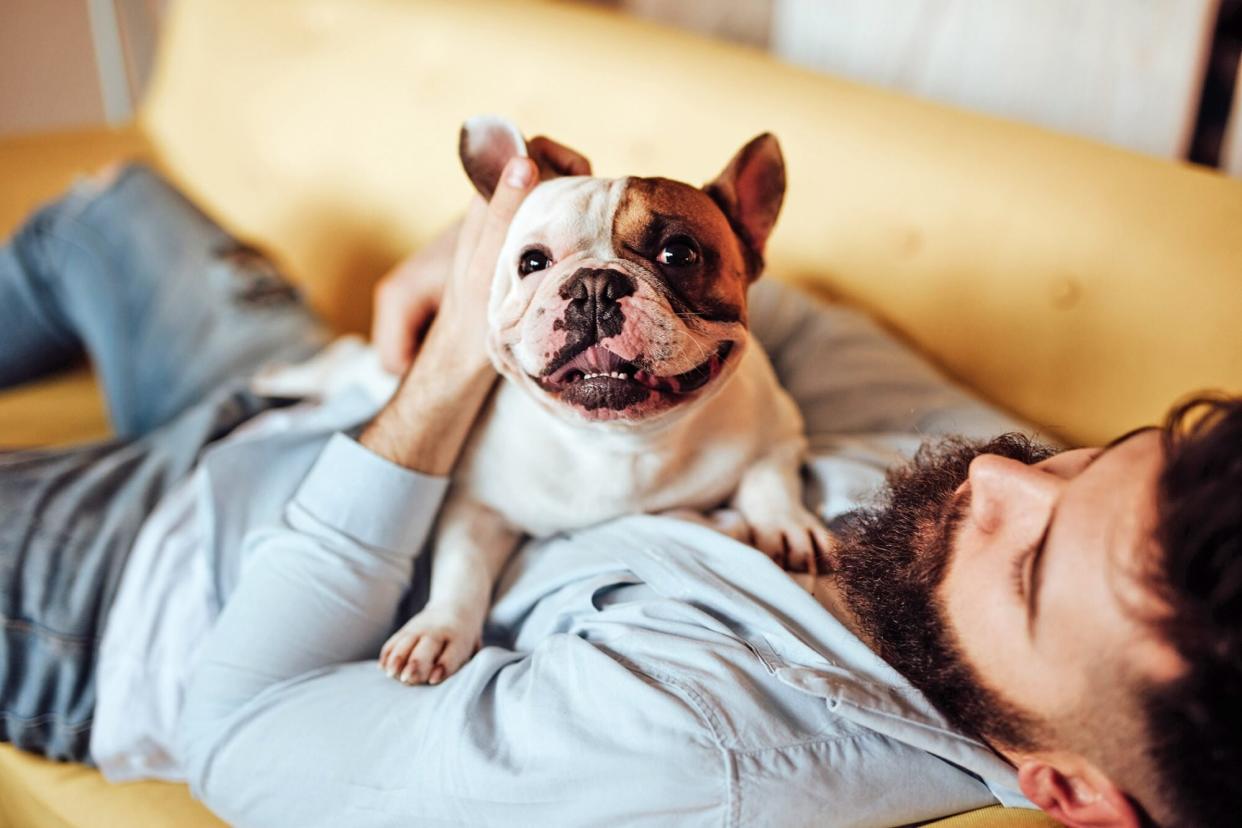Gabapentin for Dogs Can Help Pups Suffering From Seizures, Anxiety, and Chronic Pain

Anchiy / Getty
TABLE OF CONTENTS
On This Page
What Is Gabapentin?
Gabapentin Side Effects
Gabapentin Dosage
Can Dogs Overdose on Gabapentin?
How To Give a Dog Gabapentin
How Long Does It Take for Gabapentin to Work?
Gabapentin Drug Interactions and Warnings
If your dog experiences seizures, anxiety, or chronic pain, it might feel like you're always at your veterinarian's office for a new test or treatment. These conditions can be difficult to manage, but gabapentin for dogs can help.
This drug has a several uses in both human and veterinary medicine, but it's a popular treatment for canine pain with limited side effects. But you'll still need to be sure you give your dog the correct dosage.
Here's everything else you should know about gabapentin and dogs.
What Is Gabapentin for Dogs?
Gabapentin is an anticonvulsant drug used in humans and some animals to treat seizures, neuropathic pain, and anxiety. The drug is structurally similar to gamma-aminobutyric acid (GABA), an inhibitory neurotransmitter responsible for communication in the central nervous system.
GABA blocks signals associated with seizures, pain, and anxiety, and gabapentin appears to work in a similar manner.
Pain Management
Veterinarians most commonly prescribe gabapentin for dogs to manage chronic pain, usually in conjunction with other pain medications like carprofen. Gabapentin works best on nervous system pain, but it can be effective against pain from conditions like osteoarthritis because of the way chronic pain changes pain pathways in the brain. Gabapentin is not as effective for acute pain because of the way it works in the brain.
Seizure Control
Gabapentin is sometimes used as a complementary treatment for other seizure control drugs in dogs with epilepsy or other seizure disorders. Although it may be used alone, it is typically less effective than other anticonvulsants.
RELATED: Separation Anxiety in Dogs: Is Your Dog Stressing Out When You're Gone?
Anxiety Reduction
In recent years, veterinary behaviorists have begun using gabapentin to ease anxiety, either alone or along with drugs like trazodone.
Gabapentin Side Effects for Dogs
Mild sedation and ataxia (wobbly or drunken gait) are the most common side effects of gabapentin in dogs. The severity of these signs will vary from dog to dog and also depend on the dose. Dogs sensitive to the drug may experience extreme lethargy and sleepiness. Contact your vet if your dog seems too sedated or "drunk" while taking gabapentin; your vet may adjust the dose or change to a different drug.
Though uncommon, some dogs may develop diarrhea while on this medication.
Gabapentin Dosage for Dogs
The dosage of gabapentin will vary depending on the condition being treated and any other drugs the dog is taking. For seizure control, most dogs are dosed at 10 to 20 milligrams per kilogram of body mass every six to 12 hours.
Lower doses are typically used for pain management, often ranging from 5 to 10 milligrams per kilogram of body mass every six to 12 hours. For ease of administration, most vets prescribe gabapentin to be given every eight hours.
Can Dogs Overdose on Gabapentin?
It's possible for dogs to overdose on gabapentin, but serious complications are unlikely. In most cases, gabapentin overdose causes diarrhea, extreme sedation, lethargy, and ataxia. Although overdose is typically not serious, dogs still need veterinary attention. Contact your vet for advice—you may be instructed to induce vomiting or bring your dog to the clinic for supportive care.
How To Give a Dog Gabapentin
Dogs take gabapentin orally as a capsule, tablet, or liquid solution. They can consume it with or without food. Many dog parents find it helpful to hide the tablet or capsule in something like a pill pocket. If you mix gabapentin with food, watch your dog to ensure it's all consumed. Try to give gabapentin as close as possible to the prescribed intervals (often every eight hours). If you miss a dose, give it right away and continue the schedule as directed.
It's important to note that the commercially available solution may contain xylitol, a sweetener that is toxic to dogs. If your dog needs a low dose of gabapentin, your vet may send you to a compounding pharmacy to have a safe version made.
RELATED: CBD for Dogs: What It Is and How It Might Help With Your Dog's Pain or Anxiety
How Long Does It Take for Gabapentin to Work in Dogs?
For most dogs, gabapentin will start to work within an hour or two of dosing. It typically lasts about six hours. However, each dog is different. Talk to your vet if gabapentin does not seem to be helping your dog.
Gabapentin Drug Interactions and Warnings
Gabapentin is safe to use along with many other prescription drugs. Be careful if your dog is taking it along with hydrocodone and morphine. Each drug can change the way the others work in the body. Antacids may decrease the efficacy of gabapentin, so dosing of gabapentin should be given at least two hours apart from antacid doses.

